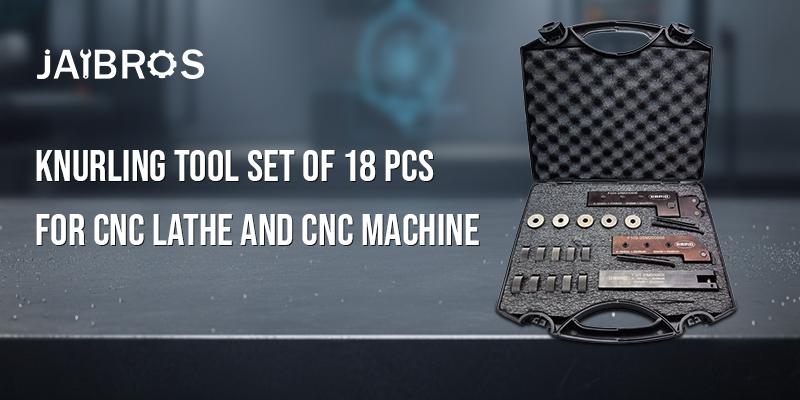Choosing the Best Knurling Tool for CNC Turning

Knurling Tool: Functions, Types, and Applications
In precision machining, achieving a secure grip on a metal surface is a fundamental step in increasing a component's function and use. Knurling tools are a key component in this process, especially when performing CNC processes requiring precision and repeatable actions. With an appropriate tool, you will achieve improved surface finish, efficiency, overall cost, and durability in production.
This guide will assist you in evaluating which knurling tool is most appropriate for CNC turning. You will use this guide to find which tool makes the most sense as a long-term investment and is reliable in your workshop or in your manufacturing facility.
Significance of a Knurling Tool
A knurling tool is designed and purpose-built for one reason: to emboss a textured pattern onto a metal surface. This is very different than cutting, where you are reducing or removing material. Because of the knurling tool, we actually are displacing material in a surface condition to create a series of ridges or diamonds to provide superior grip. Patterns are typically seen on handles, knobs, machine components, and tool surfaces.
In a CNC operation, applying knurling creates one more layer of uniformity and a layer of precision, whereas when knurling manually, it is far more difficult to achieve uniformity and precision. A CNC knurling tool allows the CNC operator to contribute one additional layer of precision.
Why Knurling Matters in CNC Turning
Knurling is not only about creating a surface with texture; it is about performance. In various industries a knurled finish ensures parts can be held, twisted, and gripped without slippage. Knurled components are widely used in applications with automotive parts, machine handles, and fasteners.
When you use a knurling tool for CNC turning, you can finish with a sophisticated look as well as provide functional design features such as added friction, safety, and easier usability. Additionally, knurled components are oftentimes features that enhance the overall look of a product to provide elegance and higher-quality appeal.
Types of Knurling Patterns
Before selecting knurling tools, you must realize that there are several patterns to knurling. Every type of knurling serves a purpose:
-
Straight Knurling—This knurling consists of parallel lines and is typically used for basic gripping surfaces.
-
Diagonal Knurling—This knurling creates angled lines that provide traction and control.
-
Diamond Knurling—The most common knurling pattern that creates a crisscrossed line to provide max gripping patterns as well as visual appeal.
Either pattern you choose will depend on the use or what you are producing. A knurling tool for CNC gives you the option to switch between each type of pattern quickly and easily with little setup.
Crucial Considerations When Choosing a Knurling Tool
1. Material
Not every tool will work with all types of metals. Stainless steel, for example, as well as aluminum, brass, and mild steel, may require a different pressure or type of wheel. Select a knurling tool that is guaranteed to work with common materials.
2. Tool Quality/Tool Life
Select a quality tool; a high-speed steel or carbide tool will be more selective and stronger. A durable tool for CNC will generate a longer overall life and consistent results, as you can repeat these and perform CNC knurling higher amounts.
3. Pattern Accuracy
CNC turning should be both precise and repeatable. You need to have confidence the knurling tool will cut a clean and accurate pattern without deforming the workpiece.
4. Adjustment Process
Some tools (normally a little more expensive) offer a better range of quick adjustment settings and/or scale, which, in the case of pitch sizes or depth, allows for a faster setup of the tool each time you switch jobs. Any time saved is valuable time.
5. Tool Holding/Stability
Tool holding and stability can be undervalued, but the design and the tool itself offer a sense of rigidity and stability to the dweller. This simple factor will eliminate
Frequent Mistakes to Avoid with Knurling Tools
Regardless of the quality of the knurling tools, incorrect use can lead to unsatisfactory surface finish and ruined pieces. Here are common pitfalls to avoid:
-
Too much pressure on the first pass.
-
Not choosing an appropriate wheel pitch for the workpiece material.
-
Not being aligned perpendicular with the centerline.
-
No coolant, which can cause overheating and poor surface performance.
By being mindful of these considerations, you can ensure smoother operations and longer tool life on your CNC knurling tool.
Maintenance and Care Recommendations
Performing maintenance on your knurling tool for CNC should be undertaken on a regular schedule to maintain and maximize its performance. After every use, clean your tool to ensure no dirt and debris collects. Assess your wheels for wear and damage, and replace the wheel as needed. Using the appropriate lubrication and storing the tool properly will improve the performance of the tool over time.
Regular maintenance ensures the knurling tool for CNC turning is sharp and operating correctly for your various projects, maintaining the same quality across your various projects.
Benefits of Buying a Quality Knurling Tool
Buying a quality knurling tool is a good return on investment. Here are the reasons why:
-
A higher quality product and surface finish.
-
Higher efficiency and less downtime.
-
Less rejection due to better accuracy.
-
More productivity while turning on CNC machines.
In conclusion, if machinists are using the proper tool, the results will be greater with less energy expended, creating more throughput and happy customers.
conclusion
Choosing the right knurling tool for CNC lathe machining is valued not just for the cost of the tool, but also for the finishing, precision of the process, and productivity gains with the right tool. A knurling tool can help you develop accurate surface textures on your workpieces while maintaining speed and precision in production and a uniform finish on each part.
If you’re looking for quality knurling tool solutions, Jaibros has earned a reputation in precision tooling as a reliable manufacturer. We offer a host of machining and measuring tools designed for accuracy and durability to fit professional shops and industries as well.
FAQs
1. What is a knurling tool?
A knurling tool will build patterns (textures) on metal materials to facilitate grip and produce a neat appearance.
2. How do I select the best knurling tool for CNC turning?
Select the best knurling tool based on the quality of the tool itself, pattern type, and compatibility with material.
3. What patterns can a knurling tool create?
The most common patterns are straight, diagonal, and diamond patterns to create varying levels of grip.
4. Can I use a knurling tool on any metal?
Yes, but you will find softer metals are easier to knurl, and harder metals require stronger tools to knurl.
5. What is the best way to maintain a knurling tool?
Regularly clean the knurling tool, check the wheels, apply lubricant, and store properly.






